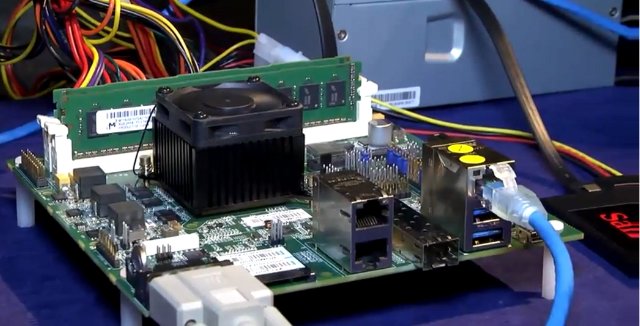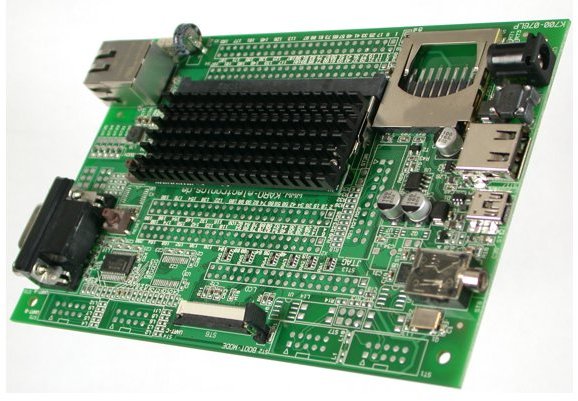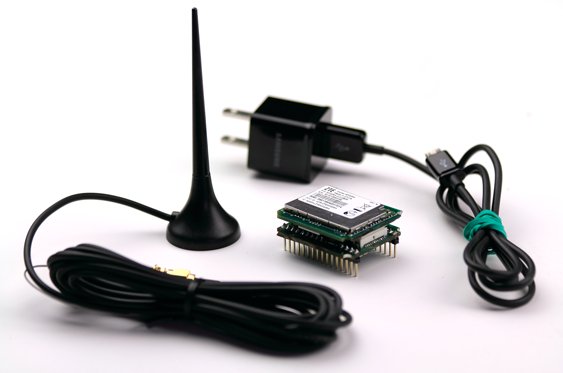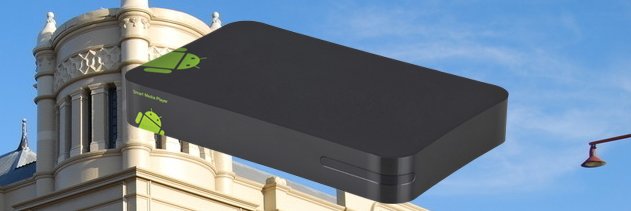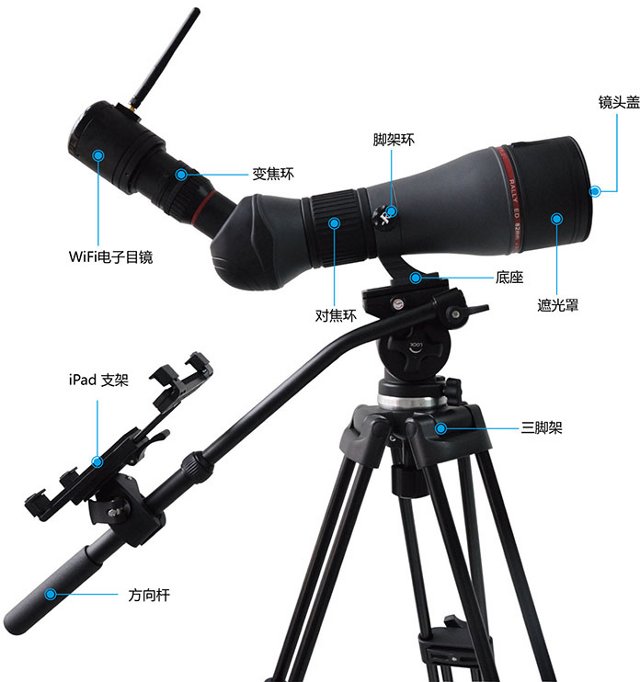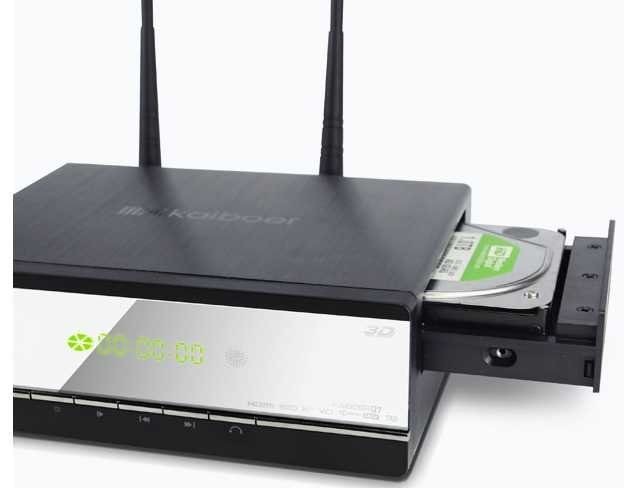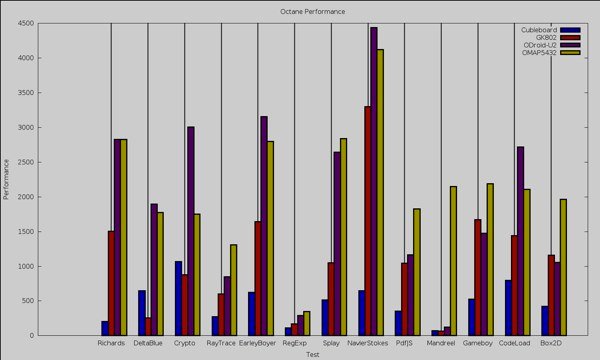Applied Micro announced X-Gene 64-Bit ARMv8 Server-on-Chip at ARM Techcon 2011, and later in 2012, they showcased Apache2 on an FPGA implementation of the chip. More recently, they showcased KVM (Kernel-based Virtual Machine) on their X-C1 hardware platform with an actual X-Gene SoC at Linaro Connect Europe 2013, and Linaro has just uploaded the video of the demo. The development board features 8 ARMv8 64-bit processors, PCI network, up to 6 SATA drives (but only one used in the demo), and they also have hardware fitted into a 1U rack. The demo below runs 4 SMP Linux virtual machines (with 2 VCPUs), including 2 ARMv7 32-bit, and 2 ARMv8 64-bit guests, running web servers concurrently on each VM using VirtIO-based network virtualization. Jean-Luc Aufranc (CNXSoft)Jean-Luc started CNX Software in 2010 as a part-time endeavor, before quitting his job as a software engineering manager, and starting to write daily news, and […]
$200 Direct Insight Triton-TXEK EvalKit for iMX6 Features Freescale i.MX 6Quad Processor
With Wandboard Quad, SABRE Lite, Nitrogen6X, and UDOO, we already have some choices when it comes to low cost Freescale i.MX 6Quad development platforms. Direct Insight, a British company, has developed another called TRITON-TXEK EvalKit for iMX6 that includes the company’s Triton-TX6Q SoM, for 130 GBP (about $200). TRITON-TXEK for iMX6 Specifications: Specifications listed for the Triton-TXEK evaluation kit include: SoC – Freescale i.MX 6Quad quad core Cortex-A9 @ 1GHz with Vivante GC2000 GPU System Memory – 1GB DDR3 Storage – 128MB NAND flash + SD card slot Display – TFT panel via 40-pin LCD flat cable header Connectivity – 10/100M Ethernet USB – USB 2.0 host + mini USB 2.0 host/device Serial – RS232on D-Sub connector Audio – 3.5mm headphone jack Power Supply – 5V Dimensions – Module: 68mm × 31mm, Baseboard: Who knows… Operating temperature – -20 to 70°C Since the only easily accessible display option is the […]
SparqEE CELLv1.0 Devkit Adds a SIM Card to Your Arduino, Raspberry Pi, or Other Hardware
There are several ways to add wireless connectivity to your sensors, relays, motors, or other devices. Bluetooth, Zigbee and Wi-Fi can all do a good job for short ranges, and the Weigthless standard will eventually provide ranges up to 10km with ultra low power on free spectrum, but it is not available right now, and a good way to achieve longer ranges is to use cellular networks. SparqEE has designed a development kit called CELLv1.0 to add GSM and 3G connectivity to the Internet of things, including (optional) shields for Arduino and Raspberry Pi boards. Here are some technical specifications for the kit: Cellular Networks – WCDMA/HSDPA 2100/1900/900MHz, GSM/GPRS/EDGE 850/900/1800/1900MHz, 384Kbps, DL3.6Mbps HSDPA via ZTE modem Protocols – Data (TCP/UDP), SMS ready Serial interface – Serial (UART, From Cellular Board is 1.8V, From Jumper board is any voltage (ex. 3.3V, 5V)) USB – (power, USART, and modem) Input Voltage – […]
$48 Ninss Tech BBA22 Android STB Powered by AllWinner A20
Ninss Tech BBA22 is an ultra cheap AllWinner A20 dual core Cortex A7 Android 4.2 media player with 1GB RAM, 4GB Flash, Wi-Fi and Ethernet. It lacks SATA, but if you don’t absolutely need this particular feature, it’s amazingly about 30 to 40 USD cheaper that competing products such as Jesurun A19 or Mele M5. Here’s an attempt at the specifications: SoC – AllWinner A20 dual core Cortex A7 @ 1.2GHz with ARM Mali-400MP2 GPU System Memory – 1GB DDR3 (256*8*4) Storage – 4GB NAND Flash (Optionally: 8 or 16 GB) + micro SD card slot Video output – HDMI, CVBS Audio output – HDMI, CVBS, and optical S/PDIF Connectivity – WI-FI 802.11 b/g/n (USB RTL8188) + 10/100M Ethernet USB – 3x USB 2.0 Host + 1x micro USB OTG Misc – IR Sensor, reset button, function key (for USB), power and status LEDs Power Supply – 5V/2A Dimensions – 148mm […]
Ostec Wi-Fi Telescopes, Wi-Fi and USB Portable Microscopes for iOS, Android, and PCs
Ostec Electro-Optical Science and Technology, is a company headquartered in Shenzhen, China, with a factory based in Guangzhou, that manufactures optical devices such as telescopes, microphones, endoscopes, and scanners that connects to your computer, or tablet via USB or Wi-Fi. Charbax of armdevices.net interviewed the company in April at the Hong Kong Electronics Fair, and uploaded the video (see bottom of post) very recently. Let’s have a closer at some of the products. KoPa WiFi Telescope (Model TW501) The first device is TW501 Wi-Fi telescope that comes with a tablet holder, and allows you to visualize the picture directly on your smartphone, tablet, or other Wi-Fi capable device either via specific Apps or via the web browser. It apparently not suited for astronomy, but can be used for bird watching, building surveillance, hiking, and any application where you may need to take close-up pictures or videos. Wi-Fi Telescope Specifications: Sensor […]
MEN Mikro Elektronik BL50W is an Embedded PC For Wireless Applications with up to 9 Antennas
MEN Mikro Elektronik Gmbh, a German company specialized in industrial embedded boards and systems, has recently unveils BL50W, an embedded PC powered by AMD G-Series APU targeting wireless applications for transportation: trains, buses, construction and agricultural machines or airplanes. The rugged device provides nine antenna slots, with support for up to 8 SIM cards and a GPS interface. BL50W Specifications: Processor – AMD G-Series single or dual core APU from AMD T24L to AMD T56N (13 Processor options). The standard version comes with AMG G-series T48N Dual Core processor @ 1.4 GHz with AMD Radeon HD 6310 GPU System Memory – 2GB DDR3 SDRAM (4GB optional) Storage – SD card slot, mSATA slot (Up to 3Gb/s), and SATA 3.0 (Up to 6Gb/s) Graphics – Radeon HD 6310 GPU by default with dual independent display support, dual DisplayPorts, and 2560×1600 maximum resolution. Video – Dedicated hardware (UVD 3) for H.264, VC-1 […]
Kaiboer Q7 Android 4.2 STB Features Dual Wi-Fi Antennas, Internal 3.5″ Hard Drive Bay
Kaiboer Q7 is an upcoming Android 4.2 media player, a bit larger than usual, based on a dual core Cortex A7 SoC, probably AllWinner A20, that features two Wi-Fi antennas, a front panel with LCD display and buttons, and a bay for a 3.5″ SATA hard drive. AndroidPC.es reports the company did not provide the full specifications, but we still know the processor is based on a dual core Cortex A7 processor, and includes 4 USB ports, HDMI, composite and component video outputs, coaxial and optical SPDIF audio outputs, an RJ45 network connector, and on-off button. It’s quite nice to have a device with an internal 3.5″ hard drive, but one downside is the addition of an small fan to keep the device and hard drive cool. The device will run Android 4.2 with a custom interface called KIUI6.0. Price and availability are unknown at this point. Jean-Luc Aufranc (CNXSoft)Jean-Luc […]
Texas Instruments OMAP5432 EVM Benchmarked Against ODROID-U2, BeagleBone Black, GK802… and an Intel Core i7-2600K based PC
Texas instruments and SVTronics announced an OMAP5 evaluation board a couple of months ago. The board features OMAP5432 dual Cortex A15, dual Cortex M4 SoC, 2GB RAM, a 4GB eMMC module, USB 3.0, SATA and more. SVTronics sent a board to Linux.com, where they wrote a short review, followed by an article benchmarking the OMAP5 EVM against AllWinner A10, Freescale i.MX6, Exynos 4412 Prime, and TI Sitara platforms, namely Cubieboard, GK802, ODROID-U2, and BeagleBone Black, all running Linux. Ben Martin, the writer, also benchmarked the board against a Linux PC powered by an Intel Core i7-2600K processor (4 cores, 8 thread, clocked at 3.4GHz, with a turbo frequency up to 3.8GHz). The board used was an early version, clocked at 800MHz, and later in September, all boards will be clocked at 1.5Ghz, so for benchmarks that stress the CPU, you could expect almost double the performance. With that in mind, […]


